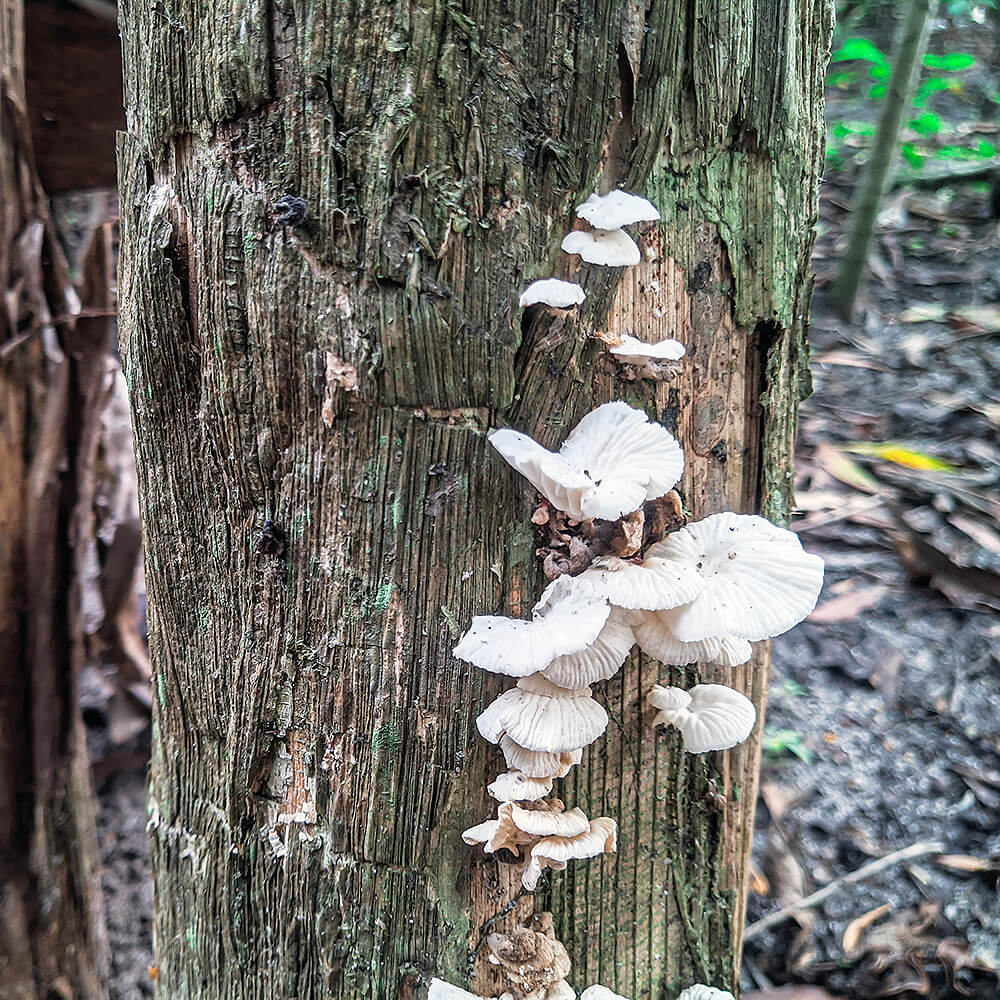Description
What is Neonothopanus nambi?
Neonothopanus nambi is a rare, bioluminescent mushroom species that glows faintly in the dark due to a naturally occurring compound known as luciferin. Native to tropical and subtropical forests, this luminous fungus produces fan-shaped caps with a woody or leathery texture and emits a greenish glow, especially in the gills.
Though not edible, Neonothopanus nambi is highly valued in scientific research and fungal biology for its light-producing properties and potential applications in bioengineering, biosensors, and environmental monitoring.
Where Does Neonothopanus nambi Grow?
This species is found in South America, Australia, and parts of Southeast Asia, where it grows on decaying wood in humid, shaded forest environments. It typically appears in small clusters on stumps, fallen branches, or buried roots. The glow is most noticeable in complete darkness, especially in humid conditions.
It is one of only a handful of mushroom species known to naturally emit light and is a focus of ongoing studies in fungal bioluminescence and metabolic pathways.
Unique Characteristics and Study Potential
A Naturally Glowing Fungus with Genetic Potential
The fruiting body of Neonothopanus nambi has a pale to tan cap, often funnel-shaped with striated margins. The gills and sometimes the stem emit a faint green bioluminescence visible to the naked eye in low light conditions. Its glow is produced by a biochemical pathway involving luciferase enzymes and is being explored as a model for bio-luminescent gene expression.
This makes the species highly desirable for researchers studying fungal genetics, metabolic engineering, and natural luminescent compounds.
Ideal for Research, Display, and Biotech Interest
While not cultivated for food, Neonothopanus nambi is ideal for lab cultivation, public displays, and classrooms focusing on fungal physiology or light-emitting organisms. The liquid culture can be expanded on agar, wood-based substrates, or sterilized grain under clean lab conditions.
This 12cc liquid culture syringe contains active Neonothopanus nambi mycelium, ready for expansion and observation.
Order Your Neonothopanus nambi Liquid Culture Today
Add a glowing wonder of the fungal world to your culture collection. Whether you’re researching bioluminescence or simply want to grow something extraordinary, Neonothopanus nambi offers science, beauty, and intrigue in one glowing package.
Taxonomic Details for Neonothopanus nambi
-
Kingdom: Fungi
-
Division: Basidiomycota
-
Class: Agaricomycetes
-
Order: Agaricales
-
Family: Omphalotaceae
-
Genus: Neonothopanus
-
Species: Neonothopanus nambi
This is a toxic mushroom. Out Grow provides this culture with the understanding that it will be used in a controlled, scientific, or educational setting. The responsibility lies entirely with the handler to ensure that it is managed appropriately. Out Grow will not be held responsible for any adverse events resulting from mishandling or accidental ingestion of the culture. This product is designed for those with a deep interest in mycology and a commitment to safe handling practices.
Neonothopanus nambi
Product Overview
Key Features
Detailed Cultivation Guide
Storage Recommendations
Cultivation and Educational Value
Safety Information
Disclaimer
Description
What is Neonothopanus nambi?
Neonothopanus nambi is a rare, bioluminescent mushroom species that glows faintly in the dark due to a naturally occurring compound known as luciferin. Native to tropical and subtropical forests, this luminous fungus produces fan-shaped caps with a woody or leathery texture and emits a greenish glow, especially in the gills.
Though not edible, Neonothopanus nambi is highly valued in scientific research and fungal biology for its light-producing properties and potential applications in bioengineering, biosensors, and environmental monitoring.
Where Does Neonothopanus nambi Grow?
This species is found in South America, Australia, and parts of Southeast Asia, where it grows on decaying wood in humid, shaded forest environments. It typically appears in small clusters on stumps, fallen branches, or buried roots. The glow is most noticeable in complete darkness, especially in humid conditions.
It is one of only a handful of mushroom species known to naturally emit light and is a focus of ongoing studies in fungal bioluminescence and metabolic pathways.
Unique Characteristics and Study Potential
A Naturally Glowing Fungus with Genetic Potential
The fruiting body of Neonothopanus nambi has a pale to tan cap, often funnel-shaped with striated margins. The gills and sometimes the stem emit a faint green bioluminescence visible to the naked eye in low light conditions. Its glow is produced by a biochemical pathway involving luciferase enzymes and is being explored as a model for bio-luminescent gene expression.
This makes the species highly desirable for researchers studying fungal genetics, metabolic engineering, and natural luminescent compounds.
Ideal for Research, Display, and Biotech Interest
While not cultivated for food, Neonothopanus nambi is ideal for lab cultivation, public displays, and classrooms focusing on fungal physiology or light-emitting organisms. The liquid culture can be expanded on agar, wood-based substrates, or sterilized grain under clean lab conditions.
This 12cc liquid culture syringe contains active Neonothopanus nambi mycelium, ready for expansion and observation.
Order Your Neonothopanus nambi Liquid Culture Today
Add a glowing wonder of the fungal world to your culture collection. Whether you’re researching bioluminescence or simply want to grow something extraordinary, Neonothopanus nambi offers science, beauty, and intrigue in one glowing package.
Taxonomic Details for Neonothopanus nambi
-
Kingdom: Fungi
-
Division: Basidiomycota
-
Class: Agaricomycetes
-
Order: Agaricales
-
Family: Omphalotaceae
-
Genus: Neonothopanus
-
Species: Neonothopanus nambi



